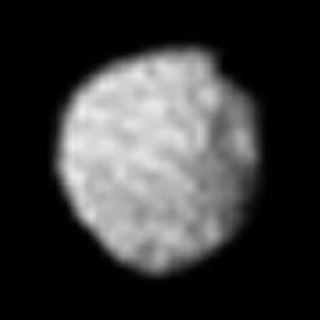Puck (moon)
Moon of Uranus From Wikipedia, the free encyclopedia
Puck is the sixth-largest moon of Uranus. It was discovered in December 1985 by the Voyager 2 spacecraft.[1] The name Puck follows the convention of naming Uranus's moons after characters from Shakespeare. The orbit of Puck lies between the rings of Uranus and the first of Uranus's large moons, Miranda. Puck is approximately spherical in shape and has diameter of about 162 km.[5] It has a dark, heavily cratered surface, which shows spectral signs of water ice.[10]
 Puck as imaged by Voyager 2 in January 1986. The image is centered on Puck's south pole. Despite the low resolution, several craters have been identified, including Bogle on the upper right | |
| Discovery[1] | |
|---|---|
| Discovered by | Stephen P. Synnott / Voyager 2 |
| Discovery date | December 30, 1985 |
| Designations | |
Designation | Uranus XV |
| Pronunciation | /ˈpʌk/[2] |
| Adjectives | Puckian[3] |
| Orbital characteristics[4] | |
| 86004.444±0.064 km | |
| Eccentricity | 0.00012±0.000061 |
| 0.76183287±0.000000014 d | |
Average orbital speed | 8.21 km/s[a] |
| Inclination | 0.31921°±0.021° (to Uranus's equator) |
| Satellite of | Uranus |
| Physical characteristics | |
| Dimensions | 162 × 162 × 162 km[5][b] |
| 81±2 km[5] | |
| 82000 km2[a] | |
| Volume | 2226100±7.8% km3[6] |
| Mass | (1.91±0.64)×1018 kg[7] |
Mean density | ~0.858 g/cm3[a] |
| ~0.019 m/s2[a] | |
| ~0.056 km/s[a] | |
| synchronous[5] | |
| zero[5] | |
| Albedo |
|
| Temperature | ~65 K[a] |
| 20.5[9] | |
Discovery and naming
Puck—the largest inner moon of Uranus—was discovered from the images taken by Voyager 2 on 30 December 1985. It was given the temporary designation S/1985 U 1.[11]
The moon was later named after the character Puck who appears in Shakespeare's A Midsummer Night's Dream, a little sprite who travels around the globe at night with the fairies. In Celtic mythology and English folklore, a Puck is a mischievous sprite, imagined as an evil demon by Christians.
It is also designated Uranus XV.[12]
Physical characteristics
Summarize
Perspective

Puck is the largest inner moon of Uranus, orbiting inside the orbit of Miranda. It is intermediate in size between Portia (the second-largest inner moon) and Miranda (the smallest of the five major moons). Puck's orbit is located between the rings of Uranus and Miranda. Little is known about Puck aside from its orbit,[4] radius of about 81 km,[5] and geometric albedo in visible light of approximately 0.11.[8]
Of the moons discovered by the Voyager 2 imaging team, only Puck was discovered early enough that the probe could be programmed to image it in some detail.[1] Images showed that Puck has a shape of a slightly prolate spheroid (ratio between axes is 0.93–1).[5] Its surface is heavily cratered[9] and is grey in color.[5] There are three named craters on the surface of Puck, the largest being about 45 km in diameter.[1] Observations with the Hubble Space Telescope and large terrestrial telescopes found water-ice absorption features in the spectrum of Puck.[8][10]
Little is known about the internal structure of Puck. It is probably made of a mixture of water ice, and may have been collisionally disrupted and reaccreted as a rubble pile.[13] The presence of a 3.0 deep 3.0 micron feature attributed to the O-H stretching mode suggests that water ice or hydrated minerals are a common component on Puck's surface.[14] Its surface is coated with a dark material similar to that found in the main rings.[10] The dark material is probably made of rocks or radiation-processed organics; it is possible that material spiralling inwards from Uranus's μ ring coats Puck's leading hemisphere as well.[13] Puck, as well as the other inner satellites of Uranus, is darker than the average inner Neptunian satellite, which could be either due to a higher level of solar irradiation at Uranus as opposed to Neptune, or a distinct composition.[14] The absence of craters with bright rays implies that Puck is not differentiated, meaning that ice and non-ice components have not separated from each other into a core and mantle.[1]
Named features
Puck has three craters named Bogle, Butz, and Lob, which are named after mischievous spirits from Scottish, German, and British folklore respectively. Details about these craters are currently unknown.

See also
Notes
References
External links
Wikiwand - on
Seamless Wikipedia browsing. On steroids.
